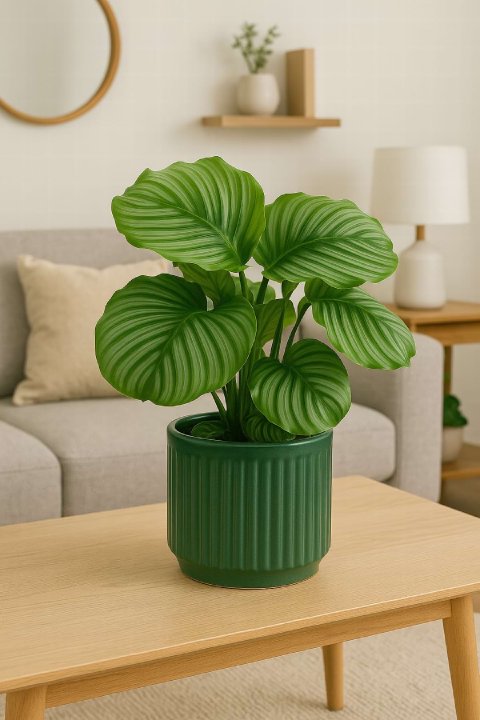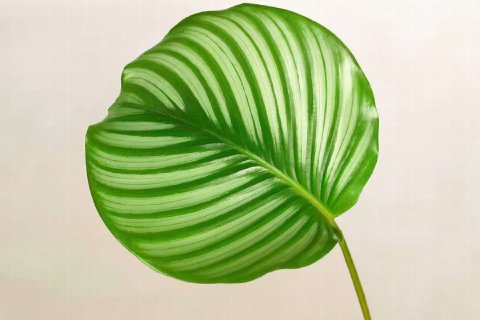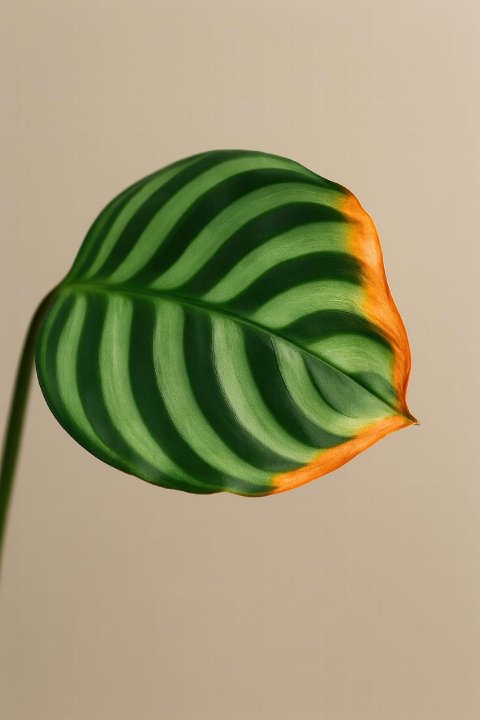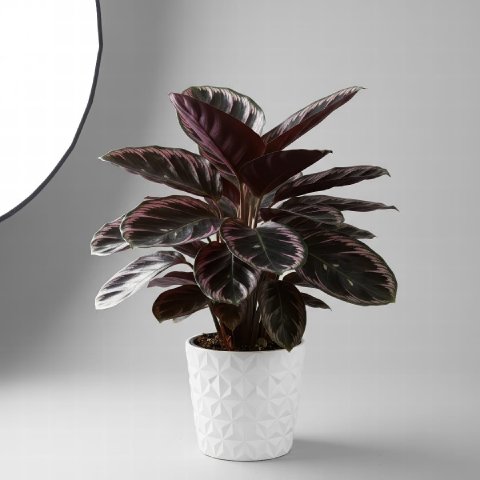
Calathea Orbifolia
Goeppertia orbifolia
Orbifolia Prayer Plant
The Calathea orbifolia is a stunning tropical houseplant, admired for its large, round leaves adorned with elegant, silver-green stripes and its fascinating ‘prayer’ movement.
📝 Calathea Orbifolia Care Notes
🌿 Care Instructions
⚠️ Common Pests
📊 Growth Information
🪴 In This Guide 🪴
🌿 The Stunning Foliage

A Work of Art
The reason for this plant’s immense popularity is its foliage. The leaves are large, almost perfectly round, and feature a stunning pattern of silvery-green stripes that radiate from the center. Each leaf is a statement piece. This plant doesn’t need to flower to be the star of the show; its leaves provide year-round beauty. Wiping the leaves with a damp cloth every few weeks will keep them clean, glossy, and best able to absorb light.☀️ Light Requirements for Calathea Orbifolia
Ideal Light for Calathea Orbifolia
Calathea orbifolia thrives in bright, indirect light. In its native Bolivian rainforests, it grows under the tree canopy, protected from the sun’s harsh rays. You must replicate this at home. Too much direct sun will quickly scorch the leaves, causing them to fade, burn, and develop brown patches.
An ideal location is near an east-facing window where it can receive gentle morning light, or several feet back from a south or west-facing window. It can tolerate medium light, but its growth may be slower.

Best & Worst Light Conditions
Best Light Conditions:
- In a bright room, out of the direct path of sunlight.
- Near a north or east-facing window.
- Filtered through a sheer curtain.
Avoid:
- Direct, intense sunlight.
- Very low-light conditions, which will lead to weak growth.
💧 Watering Needs for Calathea Orbifolia
Watering Needs and Water Quality
This is where Calatheas demand attention. They like their soil to be consistently moist, but never waterlogged or soggy. The goal is to water just as the top inch of soil begins to feel dry.
Even more important is the type of water you use. Calatheas are famously sensitive to the minerals, salts, and chemicals (like fluoride and chlorine) found in most tap water. Using tap water is the number one cause of brown, crispy leaf edges.
- Best Water: Filtered water, distilled water, or rainwater.
- Good Alternative: If you must use tap water, let it sit out for at least 24 hours to allow some of the chlorine to evaporate.
How to Water
Water thoroughly until it drains from the bottom of the pot. Discard any excess water from the saucer. Check the soil every few days and re-water when the top inch is dry. For even moisture distribution and to prevent dry spots, consider bottom watering, which is especially beneficial for Calatheas. Learn more about the fundamentals in our general guide to 👉 watering houseplants.💦 Humidity Needs for Calathea Orbifolia

The Most Important Factor: Humidity
If there is one non-negotiable for a happy Calathea orbifolia, it is high humidity. As a true tropical diva, it’s one of the top 👉 plants that love humidity and requires moist air to keep its large, delicate leaves in pristine condition.
- Ideal Humidity: 60% or higher.
- Signs of Low Humidity: This is the primary cause of 👉 brown, crispy leaf edges.
How to Increase Humidity
- Use a Humidifier: This is by far the most effective and reliable method. Placing a humidifier near your plant will make a world of difference.
- Group Plants Together: Grouping plants creates a more humid micro-environment.
- Pebble Tray: A tray of pebbles and water placed under the pot can increase local humidity through evaporation.
- Location: A naturally humid room, like a well-lit bathroom, is an ideal home for an orbifolia.
Misting provides only a very temporary boost and is not a substitute for consistent high humidity. Learn more in our general guide to 👉 improving houseplant humidity.
🙏 The 'Prayer Plant' Movement

What is Nyctinasty?
One of the most enchanting qualities of the Calathea orbifolia is its daily movement. Like other members of the Marantaceae family (the “Prayer Plants”), it exhibits a behavior called nyctinasty.
- Day: During the day, the leaves are held horizontally to maximize light absorption.
- Night: As evening approaches, specialized joints at the base of the leaves (called pulvini) cause the leaves to fold upwards, almost like hands in prayer.
This movement is a sign of a healthy, active plant responding to its environment. It’s a fascinating process to watch and one of the unique joys of owning a prayer plant.
🌱 Soil Requirements for Calathea Orbifolia
What Kind of Soil Does Calathea Orbifolia Like?
The ideal soil needs to strike a balance between retaining moisture and providing good drainage. A standard potting mix is often too dense.DIY Soil Mix Recipe for Calathea Orbifolia
A good, simple mix for an orbifolia is:
- 2 parts peat moss or coco coir (for moisture retention)
- 1 part perlite (for aeration and drainage)
- A handful of orchid bark (to create air pockets)
🪴 Potting and Repotting Calathea Orbifolia
When to Repot
Repot your Calathea orbifolia every 1-2 years in the spring, or when it becomes root-bound. This is also the only time you can propagate the plant.How to Repot
Choose a pot that is only 1-2 inches larger in diameter. Gently remove the plant, and if desired, this is the time to divide it for propagation. Place it in the new pot with fresh, appropriate soil, and water it well.🐛 Common Pests
Pests That May Affect Calathea Orbifolia
Their need for high humidity makes them a prime target for one pest in particular.
- Spider Mites: These are the #1 enemy of Calatheas. They thrive in the warm conditions Calatheas love, especially if humidity drops. Look for fine webbing on the undersides of leaves and a stippled, faded appearance. Keeping humidity high is the best prevention.
- Mealybugs: Can hide in the crevices where leaves meet stems.
- Thrips: Less common, but can cause silvery patches on leaves.
🩺 Common Problems

Troubleshooting Calathea Orbifolia Issues
Calatheas are quick to show you when they are unhappy.
- Brown, Crispy Edges: This is the most common issue. It is a direct result of either low humidity or minerals in tap water. This is not a sign of disease, but rather an environmental issue that needs correcting.
- Yellowing Leaves: Typically a sign of overwatering. The soil is being kept too wet, suffocating the roots. Allow the top inch of soil to dry before watering again.
- Curling Leaves: This is the plant’s way of saying it’s thirsty. The leaves curl to conserve water. Check the soil and give it a good drink if dry.
- Root Rot: The most serious issue, caused by chronic overwatering and poor drainage.
- Pest Damage: Stippling, webbing, or discoloration can signal a pest infestation.
🌿 How to Propagate Calathea Orbifolia
Creating New Plants
Unlike many vining houseplants, Calathea orbifolia cannot be propagated from a stem or leaf cutting. The only successful method is by division.Propagation by Division
For a photo-led walkthrough of splitting clumping houseplants like Calathea, see our step-by-step plant division guide.
- Do it During Repotting: This method should only be attempted when you are already repotting a healthy, mature plant.
- Separate the Rhizomes: Gently remove the plant from its pot and carefully tease the soil away from the roots. You will see that the plant grows from underground rhizomes, which can be separated into clumps.
- Ensure Viability: Make sure each clump has a healthy root system and at least 2-3 leaves.
- Pot Separately: Pot each new division into its own appropriately sized container with fresh soil. Keep them warm and humid as they recover from the shock.
🌟 PRO Tips for a Thriving Calathea Orbifolia
✅ Humidity is Everything: This cannot be overstated. If you want pristine leaves, invest in a humidifier. Aim for 60% humidity or more. Your Orbifolia will thank you for it.
💧 Water Wisely: Ditch the tap water. Switching to filtered, distilled, or rainwater is the single best thing you can do to prevent brown, crispy edges.
🔄 Rotate for Symmetry: The large leaves will all turn towards the light. Give your plant a quarter turn every week to encourage an even, symmetrical shape and prevent it from leaning.
🧼 Keep Leaves Clean: Gently wipe the top and bottom of the large leaves with a soft, damp cloth every month. This removes dust, helps the plant breathe, and allows you to inspect for pests.
❌ No Leaf Shine: Avoid using leaf shine products. The leaves are naturally beautiful and these products can clog the pores (stomata) on the leaves.
❓ Frequently Asked Questions
Is Calathea orbifolia safe for cats and dogs?
Yes, it is completely non-toxic, making it an excellent and safe choice for households with pets.Why are the edges of my Orbifolia getting brown and crispy?
This is the most common Calathea issue. It’s almost always caused by a lack of humidity or the minerals in tap water. Boost humidity to 60%+ with a humidifier and switch to using filtered, distilled, or rainwater.Why do my Orbifolia's leaves curl inwards?
Curling leaves are a sign of thirst. The plant is trying to conserve moisture. Check the soil, and if it’s dry, give it a thorough watering. Be careful not to let it dry out completely too often.How much light does a Calathea orbifolia need?
It needs plenty of bright, indirect light. Direct sun will burn its leaves, but very low light will cause slow, weak growth. An east-facing window is often perfect.Why do the leaves of my Calathea move?
This is a fascinating trait called nyctinasty. The plant raises and lowers its leaves in response to the day-night cycle, which is how it earned the nickname ‘Prayer Plant’. It’s a sign of a healthy, responsive plant.ℹ️ Calathea Orbifolia Info
Care and Maintenance
🪴 Soil Type and pH: Moisture-retentive, well-draining
💧 Humidity and Misting: High humidity (60%+) is essential.
✂️ Pruning: Prune yellow or brown leaves at the base.
🧼 Cleaning: Wipe leaves with a damp cloth to remove dust.
🌱 Repotting: Every 1-2 years, or when rootbound.
🔄 Repotting Frequency: Every 1-2 years
❄️ Seasonal Changes in Care: Reduce watering slightly in winter; maintain high humidity year-round.
Growing Characteristics
💥 Growth Speed: Moderate
🔄 Life Cycle: Perennial
💥 Bloom Time: Rarely blooms indoors.
🌡️ Hardiness Zones: 10-12
🗺️ Native Area: Bolivia
🚘 Hibernation: No
Propagation and Health
📍 Suitable Locations: Bright rooms, bathrooms, near a humidifier.
🪴 Propagation Methods: By division during repotting only.
🐛 Common Pests: spider-mites, mealybugs, and thrips
🦠 Possible Diseases: Root rot, fungal leaf spot
Plant Details
🌿 Plant Type: Rhizomatous Perennial
🍃 Foliage Type: Evergreen
🎨 Color of Leaves: Green with silver stripes
🌸 Flower Color: N/A
🌼 Blooming: No
🍽️ Edibility: Not edible
📏 Mature Size: Up to 2-3 feet
Additional Info
🌻 General Benefits: Stunning decorative foliage, non-toxic to pets, air-purifying.
💊 Medical Properties: None known
🧿 Feng Shui: Brings calming, gentle energy and represents new beginnings.
⭐ Zodiac Sign Compatibility: Cancer
🌈 Symbolism or Folklore: A new leaf, turning over a new page.
📝 Interesting Facts: It moves its leaves up and down in response to the daily light cycle, a movement known as nyctinasty.
Buying and Usage
🛒 What to Look for When Buying: Inspect leaves for brown, crispy edges, which can indicate previous stress. Check thoroughly for pests like spider mites.
🪴 Other Uses: Living decor, high-humidity terrariums.
Decoration and Styling
🖼️ Display Ideas: As a floor plant in a bright corner, on a plant stand, in a bathroom.
🧵 Styling Tips: Its bold, round leaves provide a soft contrast to plants with more angular or feathery foliage.

